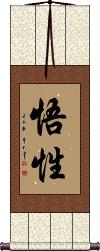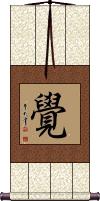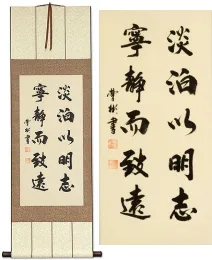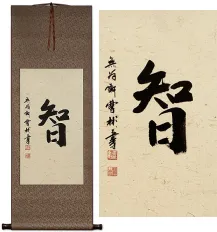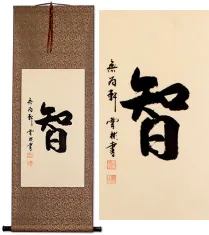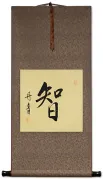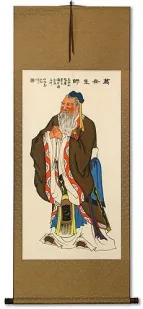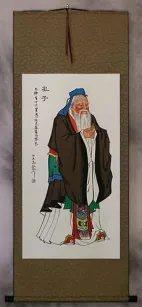Many custom options...
And formats...

Not what you want?
Try other similar-meaning words, fewer words, or just one word.
Wisdom and Understanding in Chinese / Japanese...
Buy a Wisdom and Understanding calligraphy wall scroll here!
Personalize your custom “Wisdom and Understanding” project by clicking the button next to your favorite “Wisdom and Understanding” title below...
Power of Understanding and Wisdom
悟性 means the power of understanding and insight in Chinese.
It is often associated with Neo-Confucianism. In that regard, it means to realize, perceive, or have the perception of man's true nature. It can also mean finding your soul, the soul of others, or the soul of the world. Some will translate this simply as the state of being “savvy.”
In Japanese, this is often translated as wisdom and understanding.
Seeking Wisdom
智を磨く is an old obscure Japanese phrase that means to refine, cultivate, or improve one's wisdom.
This is the mantra of one who is a seeker of wisdom. They will always want to polish, shine, refine, improve, and expand their knowledge and understanding.
Note: Because this selection contains some special Japanese Hiragana characters, it should be written by a Japanese calligrapher.
1. Right Understanding / Right Perspective / Right View / Perfect View
Samyag Dristhi / Samyag Drsti / Samma Ditthi
正見 is one of the Noble Eightfold Paths of Buddhism. Right View, along with the Right Thought, constitutes the path to Wisdom.
To get to the correct view of the world, you must first understand and follow Four Noble Truths.
Note: This term is exclusively used by devout Buddhists. It is not a common term, and is remains an unknown concept to most Japanese and Chinese people.
See Also: Buddhism | Enlightenment | Noble Eightfold Path
Awareness
覺 can mean to feel; to figure out; thinking; awake; aware; bodhi; knowing; understanding; enlightenment; illumination; apprehend; perceive; realize.
覺 is a character that is impossible to define in a single word.
This term is often associated with Buddhism where it's understood to be: Illumination, enlightenment, or awakening in regard to the real in contrast to the seeming. However, it can also refer to enlightenment in regard to morality and evil.
Notes:
In Japanese, this can be the personal name Satoru.
In certain context, and only when pronounced as "jiao" in Chinese, it can refer to a nap, sleep or the state of sleeping. However, as a single character on a wall scroll, everyone will read this with the awareness or enlightenment context.
By no means is this the only way to write enlightenment. In fact, you should only choose this character if you are looking more for a word meaning awareness.
See Also: Enlightenment | Wisdom | Knowledge
Realization and Knowledge
知 means realization or true knowing.
This can also translate as to know, to be aware, wisdom, or higher knowledge.
From older Buddhist ideas, this can represent विद्या (Vidyā or Vidya) or ज्ञान (Jñāna or Jnana) and even the combination Sanskrit word विज्ञान (Vijñāna or Vijnana) which can translate as wisdom arising from perception or knowing.
However, 知 should be distinguished as true knowing versus having a relative understanding or 會.
This in-stock artwork might be what you are looking for, and ships right away...
Gallery Price: $198.00
Your Price: $109.88
Gallery Price: $150.00
Your Price: $78.88
Gallery Price: $150.00
Your Price: $78.88
Gallery Price: $65.00
Your Price: $39.88
Gallery Price: $100.00
Your Price: $49.88
Gallery Price: $61.00
Your Price: $33.88
Not the results for wisdom and understanding that you were looking for?
Below are some entries from our dictionary that may match your wisdom and understanding search...
| Characters If shown, 2nd row is Simp. Chinese |
Pronunciation Romanization |
Simple Dictionary Definition |
慧 see styles |
huì hui4 hui megumi めぐみ |
More info & calligraphy: Wisdom / Intelligence(1) wisdom; enlightenment; (2) (Buddhist term) prajna (one of the three divisions of the noble eightfold path); wisdom; (female given name) Megumi prajñā ; sometimes jñāna. Wisdom, discernment, understanding; the power to discern things and their underlying principles and to decide the doubtful. It is often interchanged with 智, though not correctly, for zhi means knowledge, the science of the phenomenal, while hui refers more generally to principles or morals. It is part of the name of many monks, e.g. 慧可 Huike; 慧思Huisi. |
悟性 see styles |
wù xìng wu4 xing4 wu hsing gosei / gose ごせい |
More info & calligraphy: Power of Understanding and Wisdomwisdom; understanding |
般若 see styles |
bō rě bo1 re3 po je hanniya はんにや |
More info & calligraphy: Great Wisdom(1) {Buddh} prajna (wisdom required to attain enlightenment); (2) {noh} (See 般若面・1) hannya; mask of a grinning, horned demoness (represents a woman's rage and jealousy); (3) (abbreviation) (See 般若面・2) dreadful face (esp. of a woman driven mad by jealousy); terrifying facial expression; (surname) Hanniya (般賴若) Prajñā is also the name of a monk from Kabul, A.D. 810, styled 三藏法師; tr. four works and author of an alphabet.; prajñā, 'to know, understand'; 'Wisdom. ' M. W. Intp. 慧 wisdom; 智慧 understanding, or wisdom; 明 clear, intelligent, the sixth pāramitā. The Prajñā-pāramitā Sutra describes it as supreme, highest, incomparable, unequalled, unsurpassed. It is spoken of as the principal means, by its enlightenment, of attaining to nirvana, through its revelation of the unreality of all things. Other forms 般羅若; 般諄若; 鉢若; 鉢剌若; 鉢羅枳孃; 鉢腎禳; 波若, 波賴若; 波羅孃; 班若. |
菩提 see styles |
pú tí pu2 ti2 p`u t`i pu ti bodai ぼだい |
More info & calligraphy: Bodhi - Awakening Enlightenment(1) {Buddh} bodhi; enlightenment; (2) {Buddh} happiness in the next world; (place-name, surname) Bodai bodhi; from budh; knowledge, understanding; perfect wisdom; the illuminated or enlightened mind; anciently intp. by 道, later by 覺 to be aware, perceive; for saṃbodhi v. 三. |
識 识 see styles |
zhì zhi4 chih tsuguhide つぐひで |
to record; to write a footnote (1) acquaintanceship; (2) {Buddh} vijnana; consciousness; (3) (after a signature) written by...; (personal name) Tsuguhide vijñāna, "the art of distinguishing, or perceiving, or recognizing, discerning, understanding, comprehending, distinction, intelligence, knowledge, science, learning . . . wisdom." M.W. parijñāna, "perception, thorough knowledge," etc. M.W. It is intp. by 心 the mind, mental discernment, perception, in contrast with the object discerned; also by 了別 understanding and discrimination. There are classifications of 一識 that all things are the one mind, or are metaphysical; 二識 q. v. discriminating the ālaya-vijñāna or primal undivided condition from the mano-vijñāna or that of discrimination; 三識 in the Laṅkāvatāra Sutra, fundamental, manifested and discriminate; 五識 q.v. in the 起信論, i.e. 業, 轉, 現, 知, and 相續識; 六識 the perceptions and discernings of the six organs of sense; also of 8, 9, 10, and 11 識. The most important is the eight of the 起信論, i.e. the perceptions of the six organs of sense, eye, ear, nose, tongue, body (or touch), and mind, together with manas, intp. as 意識 the consciousness of the previous moment, on which the other six depend; the eighth is the ālaya-vijñāna, v. 阿賴耶, in which is contained the seed or stock of all phenomena and which 無沒 loses none, or nothing, is indestructible; a substitute for the seventh is ādāna 'receiving' of the 唯識, which is intp. as 無解 undiscriminated, or indefinite perception; there is a difference of view between the 相 and the 性 schools in regard to the seventh and eight 識; and the latter school add a ninth called the amala, or pure vijñāna, i.e. the non-phenomenal 眞如識. The esoterics add that all phenomena are mental and all things are the one mind, hence the one mind is 無量識 unlimited mind or knowledge, every kind of knowledge, or omniscience. vijñāna is one of the twelve nidānas.; Ālaya-vijñāna and mano-vijñāna; i. e. 阿梨耶 | and 分別事 |; v. 識. |
通 see styles |
tòng tong4 t`ung tung michiaki みちあき |
classifier for an activity, taken in its entirety (tirade of abuse, stint of music playing, bout of drinking etc) (n,n-suf,adj-na) (1) authority; expert; connoisseur; well-informed person; (counter) (2) counter for messages, letters, notes, documents, etc.; (noun or adjectival noun) (3) understanding (esp. of male-female relations); tact; insight; (4) supernatural powers; magical powers; (given name) Michiaki Permeate, pass through, pervade; perceive, know thoroughly; communicate; current; free, without hindrance, unimpeded universal; e.g. 神通 supernatural, ubiquitous powers. There are categories of 五通, 六通, and 十通, all referring to supernatural powers; the five are (1) knowledge of the supernatural world; (2) deva vision; (3) deva hearing; (4) knowledge of the minds of all others; (5) knowledge of all the transmigrations of self and all others. The six are the above together with perfect wisdom for ending moral hindrance and delusion. The ten are knowing all previous transmigrations, having deva hearing, knowing the minds of others, having deva vision, showing deva powers, manifesting many bodies or forms, being anywhere instantly, power of bringing glory to one's domain, manifesting a body of transformation, and power to end evil and transmigration. |
五法 see styles |
wǔ fǎ wu3 fa3 wu fa gohō |
pañcadharma. The five laws or categories, of which four groups are as follows: I. 相名五法 The five categories of form and name: (1) 相 appearances, or phenomena; (2) 名 their names; (3) 分別 sometimes called 妄想 ordinary mental discrimination of them— (1) and (2) are objective, (3) subjective; (4) 正智 corrective wisdom, which corrects the deficiencies and errors of the last: (5) 如如 the 眞如 Bhutatathata or absolute wisdom, reached through the 如理智 understanding of the law of the absolute, or ultimate truth. II. 事理五法 The five categories into which things and their principles are divided: (1) 心法 mind; (2) 心所法 mental conditions or activities; (3) 色法 the actual states or categories as conceived; (4) 不相應法 hypothetic categories, 唯識 has twenty-four, the Abhidharma fourteen; (5) 無爲法 the state of rest, or the inactive principle pervading all things; the first four are the 事 and the last the 理. III. 理智五法 cf. 五智; the five categories of essential wisdom: (1) 眞如 the absolute; (2) 大圓鏡智 wisdom as the great perfect mirror reflecting all things; (3) 平等性智 wisdom of the equal Buddha nature of all beings; (4) 妙觀察智 wisdom of mystic insight into all things and removal of ignorance and doubt; (5) 成所作智 wisdom perfect in action and bringing blessing to self and others. IV. 提婆五法 The five obnoxious rules of Devadatta: not to take milk in any form, nor meat, nor salt; to wear unshaped garments, and to live apart. Another set is: to wear cast-off rags, beg food, have only one set meal a day, dwell in the open, and abstain from all kinds of flesh, milk, etc. |
六慧 see styles |
liù huì liu4 hui4 liu hui rokue |
The six kinds of wisdom. Each is allotted seriatim to one of the six positions 六位 q. v. (1) 聞慧 the wisdom of hearing and apprehending the truth of the middle way is associated with the 十住; (2) 思慧 of thought with the 十行; (3) 修慧 of observance with the 十廻向; (4) 無相慧 of either extreme, or the mean, with the 十地; (5) 照寂慧 of understanding of nirvana with 等覺慧; (6) 寂照慧 of making nirvana illuminate all beings associated with 佛果 Buddha-fruition. They are a 別教 Differentiated School series and all are associated with 中道 the school of the 中 or middle way. |
十住 see styles |
shí zhù shi2 zhu4 shih chu jū jū |
The ten stages, or periods, in bodhisattva-wisdom, prajñā 般若, are the 十住; the merits or character attained are the 十地 q.v. Two interpretations may be given. In the first of these, the first four stages are likened to entry into the holy womb, the next four to the period of gestation, the ninth to birth, and the tenth to the washing or baptism with the water of wisdom, e.g. the baptism of a Kṣatriya prince. The ten stages are (1) 發心住 the purposive stage, the mind set upon Buddhahood; (2) 治地住 clear understanding and mental control; (3) 修行住 unhampered liberty in every direction; (4) 生貴住 acquiring the Tathāgata nature or seed; (5) 方便具足住 perfect adaptability and resemblance in self-development and development of others; (6) 正心住 the whole mind becoming Buddha-like; (7) 不退住 no retrogression, perfect unity and constant progress; (8) 童眞住 as a Buddha-son now complete; (9) 法王子住 as prince of the law; (10) 灌頂住 baptism as such, e.g. the consecration of kings. Another interpretation of the above is: (1) spiritual resolve, stage of śrota-āpanna; (2) submission to rule, preparation for Sakṛdāgāmin stage; (3) cultivation of virtue, attainment of Sakṛdāgāmin stage; (4) noble birth, preparation for the anāgāmin stage; (5) perfect means, attainment of anāgāmin stage; (6) right mind, preparation for arhatship; (7) no-retrogradation, the attainment of arhatship; (8) immortal youth, pratyekabuddhahood; (9) son of the law-king, the conception of bodhisattvahood; (10) baptism as the summit of attainment, the conception of Buddhahood. |
十智 see styles |
shí zhì shi2 zhi4 shih chih jū chi |
The ten forms of understanding. I. Hīnayāna: (1) 世俗智 common understanding; (2) 法智 enlightened understanding, i.e. on the Four Truths in this life; (3) 類智 ditto, applied to the two upper realms 上二界; (4), (5), (6), (7) understanding re each of the Four Truths separately, both in the upper and lower realms, e.g. 苦智; (8) 他心智 understanding of the minds of others; (9) 盡智 the understanding that puts an end to all previous faith in or for self, i.e. 自信智; (10) 無生智 nirvāṇa wisdom; v. 倶舍論 26. II. Mahāyāna. A Tathāgatas ten powers of understanding or wisdom: (1) 三世智 perfect understanding of past, present, and future; (2) ditto of Buddha Law; (3) 法界無礙智 unimpeded understanding of the whole Buddha-realm; (4) 法界無邊智 unlimited, or infinite understanding of the whole Buddha-realm; (5) 充滿一切智 understanding of ubiquity; (6) 普照一切世間智 understanding of universal enlightenment; (7) 住持一切世界智 understanding of omnipotence, or universal control; (8) 知一切衆生智 understanding of omniscience re all living beings; (9) 知一切法智 understanding of omniscience re the laws of universal salvation; (10) 知無邊諸佛智 understanding of omniscience re all Buddha wisdom. v. 華嚴経 16. There are also his ten forms of understanding of the "Five Seas" 五海 of worlds, living beings, karma, passions, and Buddhas. |
四道 see styles |
sì dào si4 dao4 ssu tao shimichi しみち |
(surname) Shimichi The Dao or road means the nirvana road; the 'four' are rather modes of progress, or stages in it: (1) 加行道 discipline or effort, i. e. progress from the 三賢 and 四善根 stages to that of the 三學位, i. e. morality, meditation, and understanding; (2) 無間道 uninterrupted progress to the stage in which all delusion is banished; (3) 解脫道 liberaton, or freedom, reaching the state of assurance or proof and knowledge of the truth; and (4) 勝進道 surpassing progress in dhyāni-wisdom. Those four stages are also associated with those of srota-āpanna, sakṛdāgāmin, anāgāmin, and arhat. |
文殊 see styles |
wén shū wen2 shu1 wen shu monju もんじゅ |
Manjushri, the Bodhisattva of keen awareness (Buddhist term) Manjushri; Manjusri; Bodhisattva that represents transcendent wisdom; (p,s,f) Monju (文殊師利) Mañjuśrī 滿殊尸利 -later 曼殊室利. 文殊 is also used for Mañjunātha, Mañjudeva, Mañjughoṣa, Mañjuṣvara, et al. T., hjamdpal; J., Monju. Origin unknown; presumably, like most Buddhas and bodhisattvas, an idealization of a particular quality, in his case of Wisdom. Mañju is beautiful, Śrī; good fortune, virtue, majesty, lord, an epithet of a god. Six definitions are obtained from various scriptures: 妙首 (or 頭 ) wonderful or beautiful) head; 普首 universal head; 濡首 glossy head (probably a transliteration); 敬首 revered head; 妙德 wonderful virtue (or power); 妙吉祥 wonderfully auspicious; the last is a later translation in the 西域記. As guardian of wisdom 智慧 he is often placed on Śākyamuni's left, with 普顯 on the right as guardian of law 理, the latter holding the Law, the former the wisdom or exposition of it; formerly they held the reverse positions. He is often represented with five curls or waves to his hair indicating the 五智 q. v. or the five peaks; his hand holds the sword of wisdom and he sits on a lion emblematic of its stern majesty: but he has other forms. He is represented as a youth, i. e. eternal youth. His present abode is given as east of the universe, known as 淸涼山 clear and cool mountain, or a region 寶住 precious abode, or Abode of Treasures, or 寶氏 from which he derives one of his titles, 寶相如來. One of his dhāraṇīs prophesies China as his post-nirvāṇa realm. In past incarnations he is described as being the parent of many Buddhas and as having assisted the Buddha into existence; his title was 龍種上佛 the supreme Buddha of the nāgas, also 大身佛 or 神仙佛; now his title is 歡喜藏摩尼寶精佛 The spiritual Buddha who joyfully cares for the jewel: and his future title is to be 普現佛 Buddha universally revealed. In the 序品 Introductory Chapter of the Lotus Sutra he is also described as the ninth predecessor or Buddha-ancestor of Śākyamuni. He is looked on as the chief of the Bodhisattvas and represents them, as the chief disciple of the Buddha, or as his son 法王子. Hīnayāna counts Śāriputra as the wisest of the disciples, Mahāyāna gives Mañjuśrī the chief place, hence he is also styled 覺母 mother, or begetter of understanding. He is shown riding on either a lion or a peacock, or sitting on a white lotus; often he holds a book, emblem of wisdom, or a blue lotus; in certain rooms of a monastery he is shown as a monk; and he appears in military array as defender of the faith. His signs, magic words, and so on, are found in various sutras. His most famous centre in China is Wu-tai shan in Shansi. where he is the object of pilgrimages, especially of Mongols. The legends about him are many. He takes the place in Buddhism of Viśvakarman as Vulcan, or architect, of the universe. He is one of the eight Dhyāni-bodhisattvas, and sometimes has the image of Akṣobhya in his crown. He was mentioned in China as early as the fourth century and in the Lotus Sutra he frequently appears, especially as the converter of the daughter of the Dragon-king of the Ocean. He has five messengers 五使者 and eight youths 八童子 attending on him. His hall in the Garbhadhātu maṇḍala is the seventh, in which his group numbers twenty-five. His position is northeast. There are numerous sutras and other works with his name as title, e. g. 文殊師利問菩提經 Gayaśīrṣa sūtra, tr. by Kumārajīva 384-417: and its 論 or .Tīkā of Vasubandhu, tr. by Bodhiruci 535. see list in B. N. |
末底 see styles |
mò dǐ mo4 di3 mo ti matei |
mati 摩提; devotion, discernment, understanding, tr. by 慧 wisdom. |
法智 see styles |
fǎ zhì fa3 zhi4 fa chih hōchi |
Dharma-wisdom, which enables one to understand the four dogmas 四諦; also, the understanding of the law, or of things. |
若那 see styles |
ruò nà ruo4 na4 jo na wakana わかな |
(female given name) Wakana (or 若南); 惹那那 jñāna, tr. by 智knowledge, understanding, intellectual judgments, as compared with 慧 wisdom, moral judgments; prajñā is supposed to cover both meanings. |
三世智 see styles |
sān shì zhì san1 shi4 zhi4 san shih chih sanze chi |
One of a Tathāgata's ten kinds of wisdom, i.e. knowledge of past, present, and future. |
十功德 see styles |
shí gōng dé shi2 gong1 de2 shih kung te jū kudoku |
(十功德論) Ten merits (or powers) commended by the Buddha to his bhikṣus—zealous progress, contentment with few desires, courage, learning (so as to teach), fearlessness, perfect observance of the commands and the fraternity, regulations, perfect meditation, perfect wisdom, perfect liberation, and perfect understanding of it. |
四十位 see styles |
sì shí wèi si4 shi2 wei4 ssu shih wei shijū i |
The 'forty bodhisattva positions' of the 梵網經. They are classified into four groups: (1) 十發趣 Ten initial stages, i. e. the minds 心 of abandoning things of the world, of keeping the moral law, patience, zealous progress, dhyāna, wisdom, resolve, guarding (the Law), joy, and spiritual baptism by the Buddha. These are associated with the 十住. (2) 十長養 Ten steps in the nourishment of perfection, i. e. minds of kindness, pity, joy, relinquishing, almsgiving, good discourse, benefiting, friendship, dhyāna, wisdom. These are associated with the 十行. (3) 十金剛 Ten 'diamond' steps of firmness, i. e. a mind of faith, remembrance, bestowing one's merits on others, understanding, uprighthess, no-retreat, Mahāyāna, formlessness, wisdom, indestructibility; these are associated with the 十廻向. (4) The 十地 q. v. |
四空定 see styles |
sì kōng dìng si4 kong1 ding4 ssu k`ung ting ssu kung ting shi kūjō |
四無色定 The last four of the twelve dhyānas; the auto-hypnotic, or ecstatic entry into the four states represented by the four dhyāna heavens, i. e. 四 空 處 supra. In the first, the mind becomes void and vast like space; in the second, the powers of perception and understanding are unlimited; in the third, the discriminative powers of mind are subdued; in the fourth, the realm of consciousness or knowledge) without thought is reached, e. g. intuitive wisdom. These four are considered both as states of dhyāna, and as heavens into which one who practices these forms of dhyāna may be born. |
物分り see styles |
monowakari ものわかり |
understanding (of people's circumstances and feelings); perceptiveness; sympathy; wisdom |
物解り see styles |
monowakari ものわかり |
understanding (of people's circumstances and feelings); perceptiveness; sympathy; wisdom |
胎藏界 see styles |
tāi zàng jiè tai1 zang4 jie4 t`ai tsang chieh tai tsang chieh taizō kai |
Garbhadhātu, or Garbhakośa-(dhātu), the womb treasury, the universal source from which all things are produced; the matrix; the embryo; likened to a womb in which all of a child is conceived— its body, mind, etc. It is container and content; it covers and nourishes; and is the source of all supply. It represents the 理性 fundamental nature, both material elements and pure bodhi, or wisdom in essence or purity; 理 being the garbhadhātu as fundamental wisdom, and 智 acquired wisdom or knowledge, the vajradhātu. It also represents the human heart in its innocence or pristine purity, which is considered as the source of all Buddha-pity and moral knowledge. And it indicates that from the central being in the maṇḍala, viz. the Sun as symbol of Vairocana, there issue all the other manifestations of wisdom and power, Buddhas, bodhisattvas, demons, etc. It is 本覺 original intellect, or the static intellectuality, in contrast with 始覺 intellection, the initial or dynamic intellectuality represented in the vajradhātu; hence it is the 因 cause and vajradhātu the 果 effect; though as both are a unity, the reverse may be the rule, the effect being also the cause; it is also likened to 利他 enriching others, as vajradhātu is to 自利 enriching self. Kōbō Daishi, founder of the Yoga or Shingon 眞言 School in Japan, adopted the representation of the ideas in maṇḍalas, or diagrams, as the best way of revealing the mystic doctrine to the ignorant. The garbhadhātu is the womb or treasury of all things, the universe; the 理 fundamental principle, the source; its symbols are a triangle on its base, and an open lotus as representing the sun and Vairocana. In Japan this maṇḍala is placed on the east, typifying the rising sun as source, or 理. The vajradhātu is placed west and represents 智 wisdom or knowledge as derived from 理 the underlying principle, but the two are essential one to the other, neither existing apart. The material and spiritual; wisdom-source and intelligence; essence and substance; and similar complementary ideas are thus portrayed; the garbhadhātu may be generally considered as the static and the vajradhātu as the dynamic categories, which are nevertheless a unity. The garbhadhātu is divided into 三部 three sections representing samādhi or quiescence, wisdom-store, and pity-store, or thought, knowledge, pity; one is called the Buddha-section, the others the Vajra and Lotus sections respectively; the three also typify vimokṣa, prajñā, and dharmakāya, or freedom, understanding, and spirituality. There are three heads of these sections, i. e. Vairocana, Vajrapāṇi, and Avalokiteśvara; each has a mother or source, e. g. Vairocana from Buddha's-eye; and each has a 明王 or emanation of protection against evil; also a śakti or female energy; a germ-letter, etc. The diagram of five Buddhas contains also four bodhisattvas, making nine in all, and there are altogether thirteen 大院 or great courts of various types of ideas, of varying numbers, generally spoken of as 414. Cf. 金剛界; 大日; 兩部. |
金剛界 金刚界 see styles |
jīn gāng jiè jin1 gang1 jie4 chin kang chieh kongoukai / kongokai こんごうかい |
(1) {Buddh} (See 胎蔵界・たいぞうかい・1) Vajradhatu; Diamond Realm; (2) (abbreviation) {Buddh} (See 金剛界曼荼羅・こんごうかいまんだら) Vajradathu Mandala; Diamond Realm Mandala vajradhātu, 金界 The 'diamond', or vajra, element of the universe; it is the 智 wisdom of Vairocana in its indestructibility and activity; it arises from the garbhadhātu 胎藏界q.v., the womb or store of the Vairocana 理 reason or principles of such wisdom, v. 理智. The two, garbhadhātu and vajradhātu, are shown by the esoteric school, especially in the Japanese Shingon, in two maṇḍalas, i.e. groups or circles, representing in various portrayals the ideas arising from the two, fundamental concepts. vajradhātu is intp. as the 智 realm of intellection, and garbhadhātu as the 理 substance underlying it, or the matrix; the latter is the womb or fundamental reason of all things, and occupies the eastern position as 'cause' of the vajradhātu, which is on the west as the resultant intellectual or spiritual expression. But both are one as are Reason and Wisdom, and Vairocana (the illuminator, the 大日 great sun) presides over both, as source and supply. The vajradhātu represents the spiritual world of complete enlightenment, the esoteric dharmakāya doctrine as contrasted with the exoteric nirmāṇakāya doctrine. It is the sixth element 識 mind, and is symbolized by a triangle with the point downwards and by the full moon, which represents 智 wisdom or understanding; it corresponds to 果 fruit, or effect, garbhadhātu being 因 or cause. The 金剛王五部 or five divisions of the vajradhātu are represented by the Five dhyāni-buddhas, thus: centre 大日Vairocana; east 阿閦 Akṣobhya; south 寶生Ratnasambhava; west 阿彌陀 Amitābha; north 不 空 成就 Amoghasiddhi, or Śākyamuni. They are seated respectively on a lion, an elephant, a horse, a peacock, and a garuda. v. 五佛; also 胎. |
十發趣心 十发趣心 see styles |
shí fā qù xīn shi2 fa1 qu4 xin1 shih fa ch`ü hsin shih fa chü hsin jū hosshu shin |
The ten directional decisions: (1) renouncement of the world; (2) observance of the commandments; (3) patience or endurance; (4) zealous progress; (5) meditation; (6) wisdom or understanding; (7) 願心 the will for good for oneself and others; (8) 護心 protection (of Buddha, Dharma, Sangha); (9) 喜心 joy; (10) 頂心 highest wisdom. v. 梵綱經, 心地品. |
十種智明 十种智明 see styles |
shí zhǒng zhì míng shi2 zhong3 zhi4 ming2 shih chung chih ming jusshu chimyō |
Ten kinds of bodhisattva wisdom, or omniscience, for the understanding of all things relating to all beings, in order, to save them from the sufferings of mortality and bring them to true bodhi. The ten are detailed in the Hua-yen 華嚴 sūtra in two groups, one in the 十明品 and one in the 離世間品. |
物わかり see styles |
monowakari ものわかり |
understanding (of people's circumstances and feelings); perceptiveness; sympathy; wisdom |
物分かり see styles |
monowakari ものわかり |
understanding (of people's circumstances and feelings); perceptiveness; sympathy; wisdom |
解深密經 解深密经 see styles |
jiě shēn mì jīng jie3 shen1 mi4 jing1 chieh shen mi ching Gejinmikkyō |
Sandhinir mokcana vyuha sutra, a yogic text on awareness and meditation, translated as the Wisdom of Buddha Sūtra on Understanding Profound and Esoteric Doctrine |
知一切衆生智 知一切众生智 see styles |
zhī yī qiè zhòng shēng zhì zhi1 yi1 qie4 zhong4 sheng1 zhi4 chih i ch`ieh chung sheng chih chih i chieh chung sheng chih chi issai shushō chi |
The Buddha-wisdom which knows (the karma of) all beings. |
Variations: |
monowakari ものわかり |
understanding (of people's circumstances and feelings); perceptiveness; sympathy; wisdom |
Click here for more wisdom and understanding results from our dictionary
The following table may be helpful for those studying Chinese or Japanese...
| Title | Characters | Romaji (Romanized Japanese) | Various forms of Romanized Chinese | |
| Power of Understanding and Wisdom | 悟性 | gosei | wù xìng / wu4 xing4 / wu xing / wuxing | wu hsing / wuhsing |
| Seeking Wisdom | 智を磨く | chiomigaku | ||
| 1. Right Understanding Right Perspective Right View Perfect View | 正見 正见 | sei ken / seiken | zhèng jiàn zheng4 jian4 zheng jian zhengjian | cheng chien chengchien |
| Awareness | 覺 觉 | gaku / satoru | jué / jiào jue2 / jiao4 jue / jiao jue/jiao | chüeh chiao chüehchiao |
| Realization and Knowledge | 知 | chi | zhī / zhi1 / zhi | chih |
| In some entries above you will see that characters have different versions above and below a line. In these cases, the characters above the line are Traditional Chinese, while the ones below are Simplified Chinese. | ||||
Successful Chinese Character and Japanese Kanji calligraphy searches within the last few hours...
